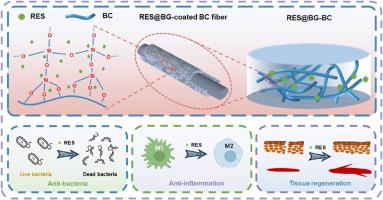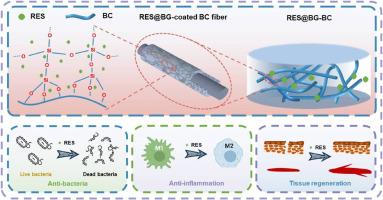Fabrication of resveratrol-loaded bioactive glass-modified bacterial cellulose for wound treatment
IF 4.5
2区 化学
Q2 POLYMER SCIENCE
引用次数: 0
Abstract
Resveratrol (RES) exhibits a wide range of pharmacological activities, including antibacterial, anti-inflammatory, and antioxidant properties, making it a promising candidate for improving the multifunctionality of bacterial cellulose (BC)-based dressings. Nevertheless, the low water solubility and poor stability of RES have significantly limited its bioavailability. Herein, bioactive glass (BG) with good biological properties and drug loading capacity was used as a medium to introduce RES into the BC network structure, and a novel RES-loaded BG modified BC (RES@BG-BC) dressing was developed by using the sol-gel synthesis and hydrolysis reaction. Results of characterization confirmed successful construction of RES@BG coating on the surface of BC nanofibers with nanoporous network. The obtained RES@BG-BC exhibited favorable thermostability, fast water absorption and enhanced mechanical properties. Notably, RES@BG-BC exhibits a superior sustained release capacity of RES (continuous release for 120 h) and achieves a higher cumulative release amount (133.70 ± 1.84 μmol/L) compared to RES@BC. Importantly, the introduction of RES endowed the BC-based dressing with favorable broad-spectrum antibacterial properties, excellent antioxidation and anti-inflammatory properties. While the promotion of the NIH3T3 proliferation, HUVECs migration and the VEGF secretion was attributed to the synergistic effect of RES and BG. These findings illustrate that the developed RES@BG-BC dressing hold significant therapeutic potential in wound treatment, and offer a novel strategy for incorporating BC with Chinese herbal extracts.


负载白藜芦醇的生物活性玻璃改性细菌纤维素的制备
白藜芦醇(Resveratrol, RES)具有广泛的药理活性,包括抗菌、抗炎和抗氧化特性,使其成为改善细菌纤维素(BC)基敷料多功能性的有希望的候选者。然而,RES水溶性低,稳定性差,严重限制了其生物利用度。本文以具有良好生物性能和载药能力的生物活性玻璃(BG)为介质,将RES引入到BC网络结构中,并采用溶胶-凝胶合成和水解反应制备了一种新型的载RES BG修饰BC (RES@BG-BC)敷料。表征结果证实了在BC纳米纤维表面成功构建RES@BG纳米孔网络涂层。所得RES@BG-BC具有良好的热稳定性、快速吸水性能和增强的力学性能。值得注意的是,RES@BG-BC具有较好的RES缓释能力(连续释放120 h),累积释放量(133.70±1.84 μmol/L)高于RES@BC。重要的是,RES的引入赋予了bc基敷料良好的广谱抗菌性能,优异的抗氧化和抗炎性能。而促进NIH3T3增殖、HUVECs迁移和VEGF分泌则归因于RES和BG的协同作用。这些发现表明,所开发的RES@BG-BC敷料在伤口治疗中具有显著的治疗潜力,并为将BC与中草药提取物结合提供了一种新的策略。
本文章由计算机程序翻译,如有差异,请以英文原文为准。
求助全文
约1分钟内获得全文
求助全文
来源期刊

Polymer
化学-高分子科学
CiteScore
7.90
自引率
8.70%
发文量
959
审稿时长
32 days
期刊介绍:
Polymer is an interdisciplinary journal dedicated to publishing innovative and significant advances in Polymer Physics, Chemistry and Technology. We welcome submissions on polymer hybrids, nanocomposites, characterisation and self-assembly. Polymer also publishes work on the technological application of polymers in energy and optoelectronics.
The main scope is covered but not limited to the following core areas:
Polymer Materials
Nanocomposites and hybrid nanomaterials
Polymer blends, films, fibres, networks and porous materials
Physical Characterization
Characterisation, modelling and simulation* of molecular and materials properties in bulk, solution, and thin films
Polymer Engineering
Advanced multiscale processing methods
Polymer Synthesis, Modification and Self-assembly
Including designer polymer architectures, mechanisms and kinetics, and supramolecular polymerization
Technological Applications
Polymers for energy generation and storage
Polymer membranes for separation technology
Polymers for opto- and microelectronics.
 求助内容:
求助内容: 应助结果提醒方式:
应助结果提醒方式:


